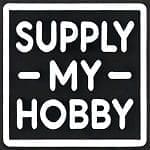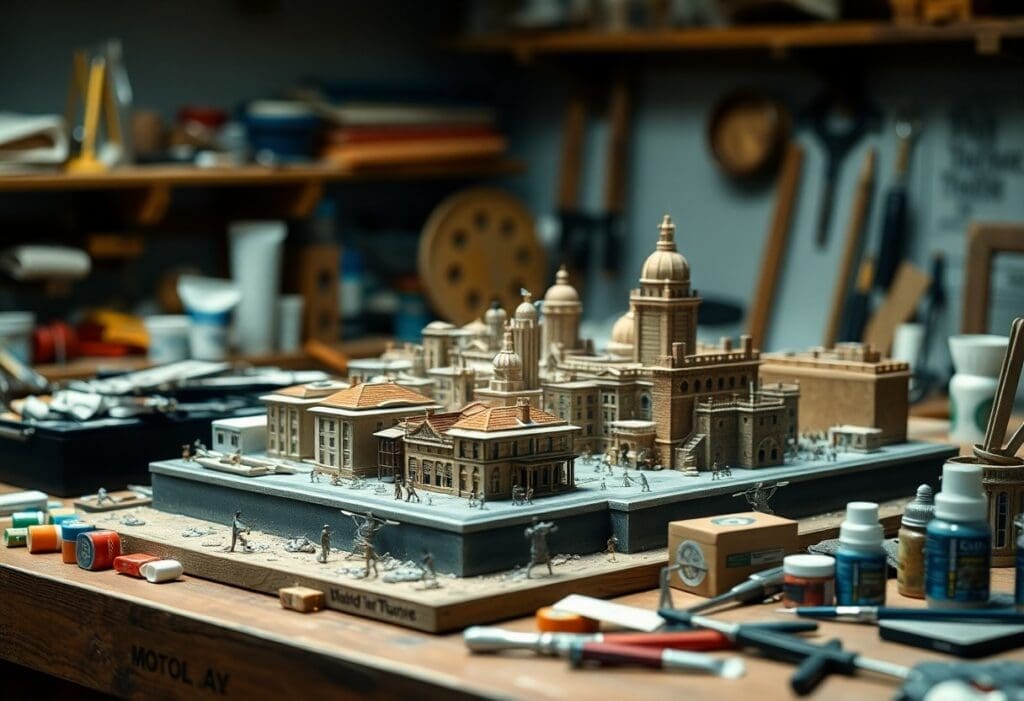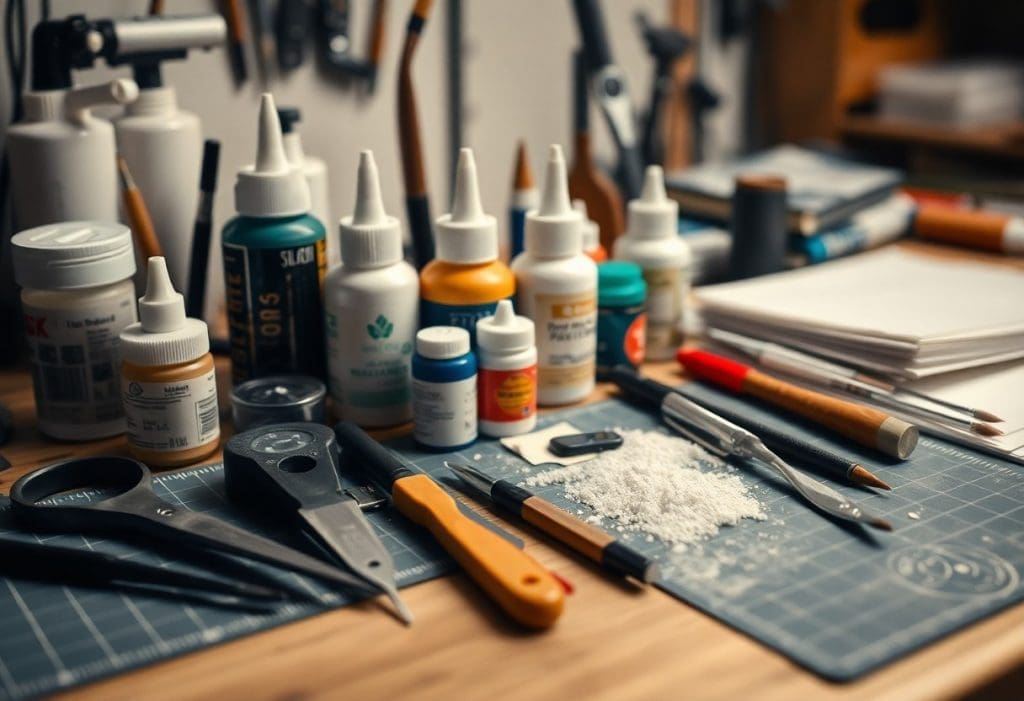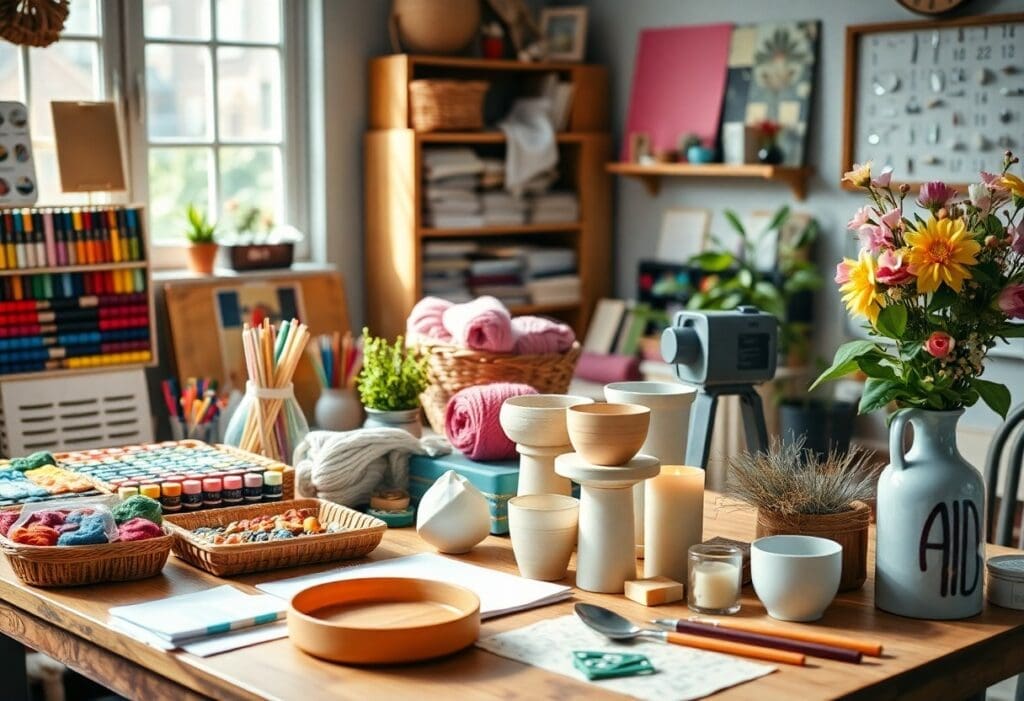There’s a fascinating world waiting for you in model building.
You can create stunning replicas of planes, cars, and ships with just the right tools and techniques.
This guide empowers you to enhance your craftsmanship, exploring top brands that define quality in each category.
Come along with me to discover what you need to turn your miniature visions into reality.
Types of Models
While exploring model building, you will come across a range of models that ignite creativity and craftsmanship.
Each type requires different tools and skills, catering to unique interests. Here’s a quick overview:
| Model Type | Top Brands |
| Aircraft Models | Tamiya, Revell, Hasegawa, Airfix, Academy |
| Automobile Models | Revell, Tamiya, Hasegawa, AMT, Italeri |
| Marine Models | Model Shipways, Revell, Trumpeter, Artesania Latina, Dumas |
| Architectural Models | Faller, BRIO, JTT Scenery, Woodland Scenics, Model Builder |
| Dioramas | Woodland Scenics, Tamiya, Italeri, MiniArt, Pegasus Hobbies |
Any model you choose to build offers an opportunity to master your craftsmanship.
Aircraft Models
Little compares to the thrill of constructing aircraft models.
You watch your hard work take flight with these detailed miniatures.
These kits often include various scales, from tiny fighters to large passenger jets.
Each model brings its own unique challenges that enhance your skill set.
Automobile Models
With automobile models, every detail matters.
You can assemble replicas of classic cars, modern vehicles, or even racing cars.
The variety in design keeps things fresh and exciting as you explore different eras and styles.
Types of automobile models range from plastic kits to die-cast collectibles.
Each comes with its own set of tools and techniques. You will need to start by identifying your preferred style to focus on.
Some models require more intricate work, while others allow for quicker assembly. Invest in quality paints and tools to achieve that perfect finish.
Marine Models
If you love the sea, marine models provide a great outlet.
These models can range from historic sailing ships to modern naval vessels.
The craftsmanship required to build a ship model can be exceptionally rewarding.
Marine models demand precise detailing. Many builders even enjoy incorporating features like working sails or lights.
The assembly often involves techniques specific to ships, including rigging and hull construction.
This enhances your skills and adds depth to your projects.
Architectural Models
An architectural model showcases your vision in a tangible format.
These models can represent anything from residential homes to grand public buildings.
By crafting these models, you will grow to understand space and structure better.
Architectural models require different materials and methods than other model types.
You can use foam board, plastic sheets, or even wood to create your designs.
Pay close attention to scale and proportion to convey your architectural ideas accurately.
Dioramas
Dioramas tell a story or capture a moment in time. These scenes can represent battles, cityscapes, or even natural wonders.
Building a diorama encourages creative thinking and attention to detail.
Dioramas combine elements from various model types into a cohesive display. You can incorporate vehicles, figures, and scenery to enhance the narrative.
Focus on composition and lighting to draw the viewer’s eye and create an engaging experience.
Models of different types invite you to explore your craftsmanship and tell your story.
Tools for Model Building
Model building is one hobby that requires tools to even get started with.
These tools help you achieve precision and quality in your crafts, whether you’re working on planes, cars, or ships.
Be sure you understand what you need, so you can enhance your experience and improve your final products.
Cutting Tools
You need cutting tools to shape materials accurately.
Options like hobby knives, scissors, and rotary tools offer different precision levels for various tasks.
Choose the right tool for your specific project to ensure clean cuts and smooth edges.
Adhesives and Fillers
Adhesives and fillers are required additions to your toolset for model building.
Choose from super glue, epoxy, and specialty model cements.
Fillers also come in handy to smooth out seams and imperfections, ensuring a finished product that looks polished.
This selection enhances how pieces bond together and maintains the model’s integrity.
Make sure to select a filler compatible with the materials you’re using.
This compatibility prevents damage and ensures durability in your models.
Paints and Finishes
While selecting paints and finishes, keep in mind the type of model you’re building.
Acrylics and enamels offer excellent options, each providing different textures and finishes.
Your choice affects the final look and feel of your creation.
Tools like airbrushes and spray cans can deliver a smooth application.
Don’t be afraid to experiment with different brands. Trial and error can help you find the perfect finish that brings your model to life.
Quality paints provide vibrant color and durability, making your model stand out.
Brushes and Applicators
You will need to have tools for applying the various cements and paints your models need, so plan ahead to pick quality brushes and applicators.
Quality brushes ensure that you apply paint and finishes evenly. For instance, fine-tipped brushes work well for details, while wider brushes cover larger areas quickly.
Select brushes suited to your specific tasks, which will give you more control, leading to a professional-looking finish in your models.
Workstation Setup
Any workspace should support your model building process. Design a setup that keeps your tools organized and at your fingertips.
A clean and structured environment makes it easier to focus on your craft.
Paints, adhesives, and tools need designated spaces.
Lighting also plays a role—it helps you see details clearly, reducing mistakes.
Organize your workstation to boost your efficiency and enhance your overall experience in model making.
Step-by-Step Guide to Model Building
Your journey into model building starts with a structured approach.
Follow these steps to create stunning miniatures, whether they’re planes, cars, or ships.
Each phase of model construction requires attention to detail and the right tools.
Below, you’ll find a breakdown of the important stages and tips to help you craft your masterpiece.
| Stage | Description |
|---|---|
| Planning and Research | An extensive plan sets the foundation for your project. Study your model type, gather reference images, and understand the historical context that influences your build. |
| Gathering Materials | While you can source materials from local shops, consider online retailers for specific items. Ensure you have the right tools, adhesives, and paints ready before you start. |
| Assembly Techniques | A good model begins with precise assembly. Follow the instructions, dry-fit parts first, and use the right adhesives to secure each component. |
| Painting Methods | Building a model isn’t just about assembly. Proper painting enhances details and gives life to your model. Use quality paints for the best results. |
| Weathering and Detailing | Weathering adds realism to your model. Apply techniques like drybrushing or washes to give your piece character and depth. |
Planning and Research
An effective model starts with careful planning and research.
Choose your subject and explore its background.
Gather information about its size, color schemes, and specifications.
Reference images will guide you through each detail as you construct your miniature.
Gathering Materials
While sourcing supplies for model making, focus on quality over quantity.
Look for kits specific to your model type.
Ensure you have important supplies like scissors, tweezers, cutting mats, and a variety of paints.
Check if you need any additional tools for finer details.
Model construction requires specific materials to achieve the best results.
Research the best brands for your chosen model (we gave you a nice list earlier on this post to get you started – please click through to Amazon on those affiliate links to help support the website), as different brands offer various quality levels in materials.
If you purchase a complete kit, you can expect to save time and ensure you have everything you’ll need to get started on your project.
Assembly Techniques
Assembly techniques play a big role in the final appearance of your model.
Always start by reading through the instructions thoroughly. This preparation will enable you to visualize the build and understand how each part fits together.
Build your model step-by-step, which makes a significant difference.
Prioritize dry-fitting parts before gluing them. This process will allow you to identify any adjustments needed before it’s too late.
Proper alignment and secure adhesion will provide a sturdy final product.
Painting Methods
Building a model isn’t limited to assembly; painting is equally important.
Select your colors based on your research and prepare to bring your model to life.
Achieve smooth coats with proper application techniques.
Consider using airbrushes for detailed work and spray paints for larger areas.
Thin your paints to improve flow and avoid clogging details.
By exhibiting patience in layering colors, you will yield a richer and more vibrant finish for your model.
Weathering and Detailing
Weathering adds realism to your model. Techniques such as rust effects, scratches, or dirt accumulation bring depth and story.
Simple methods like dry brushing can create highlights, making details pop.
Methods to enhance your model’s appearance include washes and pigments.
Use a wash to accentuate panel lines and surface details.
Whatever you do, experiment with varied approaches until you can identify what works best for you. It’s a journey, and the process is part of the fun.
Factors to Consider in Model Building
Despite the excitement that comes with building models, you should keep in mind several key factors for a smooth and enjoyable experience.
Let’s dive in on what these are now:
Scale and Size
You’ll quickly realize that there is a wide range of scales in model building.
It important that you choose the right scale, which not only affects the level of detail but also the space you need for display.
Smaller scales like 1:144 may fit easily on a shelf, while larger scales like 1:24 demand more room and (usually) greater craftsmanship skills.
Design Complexity
Even seasoned builders find complexity daunting.
Models with intricate details and a lot of parts require more time, patience, and skill.
More complex designs often showcase the builder’s talent but can be overwhelming for beginners.
A complex model might include advanced features like movable parts, lighting, or detailed paint schemes.
You should consider whether you’re ready for a challenge or prefer a simpler model to start.
Assess your interests and abilities before choosing a design that fits your style.
Budget Constraints
Model building can range from inexpensive kits to high-end, customized designs.
Understanding your budget helps you make informed decisions, ensuring you don’t overspend on materials or tools.
Consider the costs associated with a model, which includes the kit itself, tools, paints, and any extras like dioramas or display cases.
With a clear budget, you can plan your projects effectively and keep your enthusiasm intact without financial stress.
Time Commitment
Assuming you have limited spare time, think long and hard about how much time you want to invest in model building.
Some models take days to complete, while others can span weeks or months.
Balancing your passion with your schedule is key to enjoying the hobby.
Model building often involves multiple stages, including assembly, painting, and detailing.
Each phase requires attention, so set realistic expectations about the time you can commit.
Working on models should bring you joy, not pressure. If it becomes stressful, you may want to walk away from it for a bit to recharge and come back with a fresh perspective.
Skill Level
Any builder should evaluate their skill level. Beginners might find straightforward kits more enjoyable, while experts may seek complex models to push their limits.
You will want to challenge yourself but not to the point of frustration.
Time spent honing your skills can elevate your craftsmanship.
Start with models that suit your current abilities. This will minimize frustration and also leave space for your skills to grow over time.
Gradually, you can tackle more intricate projects as your confidence and expertise develop.
Tips for Successful Model Building
All model builders can enhance their skills by following these tips.
Engage wholeheartedly in the model building journey and embrace each step.
Develop Patience and Precision
An intricate model requires your time and focus.
Mastering the art of model building demands both patience and precision at every stage.
Take your time to perfect each detail. Rushing can lead to mistakes that require backtracking.
Keep a Clean Workspace
One important aspect of building models is maintaining a tidy workspace.
A clutter-free environment allows you to focus on your project while preventing accidental damage to your work.
Model supplies can easily create a mess. Organize your tools, materials, and models systematically.
Use bins and containers to keep small parts separated. A clean setup will position you better for creativity and prevent frustration.
You can think clearer when everything is in its place.
Learn from Mistakes
From every error, there’s an opportunity to improve. Embrace mistakes as part of the learning process.
Each misstep teaches valuable lessons, helping you refine your methods and skills.
Model building can be challenging. You might misalign parts or overlook details.
Instead of feeling discouraged, analyze what went wrong. Then, adjust your techniques accordingly.
With time, you’ll develop greater confidence and skill, turning past blunders into future successes.
Seek Community Support
With a shared passion for model building, communities can be incredibly supportive.
When you interact with fellow builders, you will add a rich dimension to your experience.
You can exchange tips, solutions, and inspiration with others.
Some other ways you can grow your skills include joining forums, attending workshops, or participating in local clubs. And by engaging with others, you’ll find your own motivation increases as well!
Shared experiences can boost your creativity and enhance your enjoyment of the craft.
Document Your Progress
Support your growth by documenting your model building journey.
Keep records of your progress, so you can reflect on your development over time.
Consider creating a journal or a digital portfolio as a simple record-keeping practice. Record each stage of your project with photos and notes.
This documentation not only tracks your growth but also creates a valuable resource for future projects.
You can refer back to it, inspiring continued learning and development.
Pros and Cons of Model Building
Model building offers both rewards and challenges that can shape your experience.
| Enhances creativity and imagination | Can be time-consuming |
| Improves fine motor skills | Requires patience and diligence |
| Brings satisfaction in completing projects | Can be costly for high-quality kits |
| Allows for learning new techniques | Potentially frustrating if mistakes happen |
| Builds community with other builders | Some projects can seem overwhelming |
Benefits of Model Building
Model building stimulates your creativity and helps you develop new skills.
As you work on different types of models, whether those be planes, cars, or ships, you will learn to pay close attention to detail.
Each project will provide a sense of accomplishment, especially when you see your hard work come together in a finished piece.
The hands-on experience also offers a great way to unwind after a stressful day.
Challenges of Model Building
Let’s not candy coat it — Model building also has its own challenges. It pays to be aware of these before diving in.
Each project varies in difficulty, requiring different levels of skill and patience.
You may find some models test your limits, which can prove frustrating at times.
However, tackling these challenges often leads to significant personal growth.
You might find the more intricate designs and the precision needed for assembly to be a huge challenge for you.
Some models will have small parts that require careful handling.
While these difficulties may seem discouraging, you’ll be able to boost your confidence as a builder by overcoming these hurdles.
You develop critical thinking and problem-solving skills along the way, pushing your abilities further than you may have thought possible.
Impact on Personal Development
Model building can contribute to your personal growth in multiple ways.
You gain valuable skills such as patience, focus, and attention to detail. These qualities will not only benefit your hobbies, but also your daily life and work.
Completing each model demonstrates your ability to follow through on a project, enhancing your self-esteem.
This craft also fosters a sense of achievement that can translate into other areas.
As you progress through different projects, you cultivate a stronger work ethic.
And when you’re able to tackle complex models, you can expect a solid boost to your self-confidence as well!
Every completed build serves as a concrete reminder of your perseverance and skill development.
Environmental Considerations
As in any hobby, I recommend you start with a clear understanding of how you can pursue your interests in the most eco-friendly way possible.
Many materials used in model kits, like plastics and paints, can impact the environment negatively if disposed of improperly.
Always strongly consider your options when purchasing and disposing of materials.
With good awareness about sustainable practices, you will enhance your model building experience.
Conclusion
So, you’ve explored the diverse world of model building, from planes to cars to ships.
You’ve seen how each type requires specific techniques and tools for detailed craftsmanship.
Dive into this hobby, refine your skills, and enjoy the satisfaction of creating miniature masterpieces.
Your journey in model building is only just beginning.



